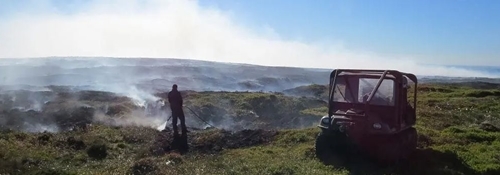
The use of the term “peatland burning” (or peatland fires or burning peat) is factually incorrect and misleading when used in conjunction with criticisms of grouse moor management.
Let’s be clear from the outset – moorland managers undertake controlled burning to manage heather and implicitly do not aim to burn the peat. Indeed, burning into the peat would be counter-productive as it would kill the heather seeds and roots. There is considerable scientific evidence that controlled burning in accordance with the Heather & Grass Burning Code has only very minimal, small-scale and transient damage to the moss and litter surface layers within UK peatlands[1]. That said we acknowledge there is a risk that controlled burns get out of control; however, these are quickly brought under control due to the Code requiring emergency plans to minimise risks if something goes wrong and so such fires rarely reach scale.
Managing the fuel load is critically important when preventing wild fires. Without controlled burning, the heather grows old and woody creating an ideal kindling for an uncontrolled wildfire – which WILL burn down into the peat! As highlighted previously the Saddleworth and Marsden moor wildfires in 2018 and 2019 and 2021 respectively demonstrate the destructive effects of intense ‘hot’ uncontrolled fires. Saddleworth moor burnt for 5 days across 1100ha, resulting in an estimated loss of 7cms of peat (or c70 years worth). Marsden moor suffered two wildfires in quick succession burning down into the peat over 1730ha (2019) and 700ha (2021). Whilst no data is available for Marsden, the National Trust on its website states “Important peat soils have been scorched and destroyed [which] will take hundreds if not thousands of years to recover.”
In contrast a recent paper by Dr Adam Pellegrini of Cambridge University and others (see here) demonstrates that controlled ‘cool’ burns can protect the carbon in the soil by reducing losses through high-intensity wildfires and can increase the stability of carbon in soil through the production of charcoal. Other scientists have also highlighted that cool burns can alter the chemical balance in soils thereby protecting the carbon and that charcoal production is as yet unaccounted for in peatland carbon budgets. The key will be to balance emitting and sequestering processes over time requiring ecologically-driven management strategies.
The evidence used by policy makers to justify changes to peatland management needs to be updated – and quickly (Natural England’s last evidence review on controlled burning was completed in 2013). At the moment policy appears to be being driven by soundbites not sound science.
See also:
[1] See Ashby M.A., Heinemeyer, A. A Critical Review of the IUCN UK Peatland Programme’s “Burning and Peatlands” Position Statement. Wetlands 41, 56 (2021). https://doi.org/10.1007/s13157-021-01400-1